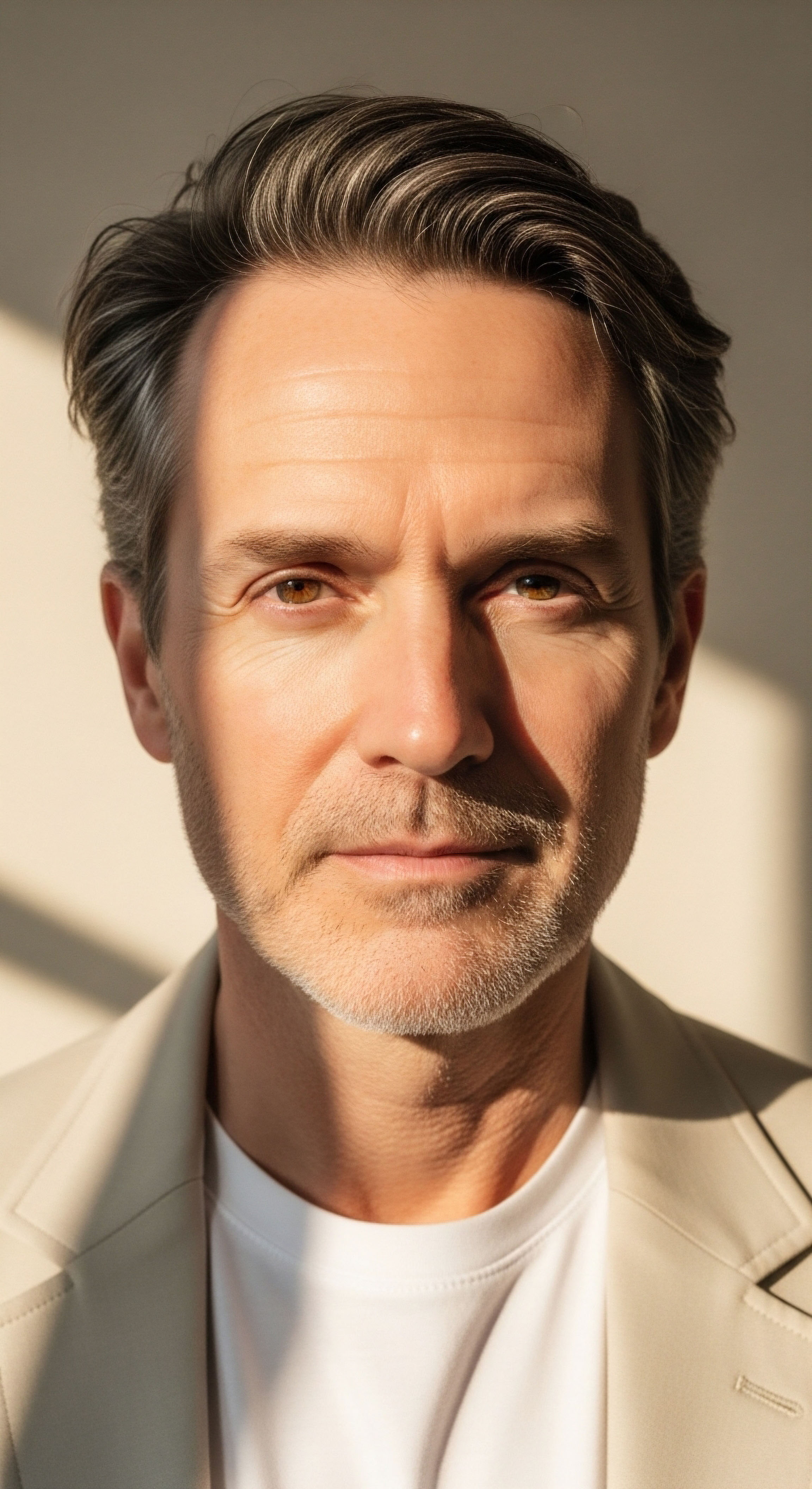

Fundamentals
You have begun a protocol of testosterone replacement therapy, a significant step toward reclaiming a sense of vitality you may have felt was diminishing. This decision was likely born from experiencing a collection of symptoms ∞ fatigue that sleep does not seem to touch, a subtle decline in physical strength, or a mental fog that clouds your focus.
Commencing endocrine system support is a profound act of taking control. Yet, you may sense that the therapeutic introduction of testosterone is one part of a larger, more intricate biological conversation. Your intuition is correct. The effectiveness of your protocol is not determined solely by the medication itself; it is deeply intertwined with the environment of your body, an environment you shape daily through your choices in nutrition and movement.
To understand this relationship, we must first appreciate how your body regulates its hormonal systems. Imagine your endocrine system as a highly sophisticated internal communication network. The key pathway for testosterone production is the Hypothalamic-Pituitary-Gonadal (HPG) axis. The hypothalamus sends a signal to the pituitary gland, which in turn signals the gonads to produce testosterone.
When external testosterone is introduced, this internal production line often slows down. The goal of a well-designed protocol, which may include agents like Gonadorelin, is to maintain the health of this natural pathway while supplementing overall levels. This is where your lifestyle choices become powerful co-therapists.

The Body’s Internal Environment
Your body’s internal landscape directly influences how it receives and utilizes supplemental testosterone. Two primary factors in this landscape are your body composition, specifically the amount of adipose (fat) tissue you carry, and your metabolic health, which is largely governed by how your body processes energy. These are not separate issues; they are deeply connected, and both have a profound impact on your hormonal balance.

Adipose Tissue a Hormone Disruptor
Excess body fat, particularly visceral fat that surrounds your internal organs, functions as an active endocrine organ. It produces an enzyme called aromatase. This enzyme’s primary job is to convert androgens, like testosterone, into estrogens. When you are on a TRT protocol, introducing testosterone into a body with high levels of aromatase activity can be counterproductive.
A significant portion of the therapeutic testosterone can be converted into estradiol, leading to a hormonal imbalance that can manifest as unwanted side effects and diminish the intended benefits of the therapy. A structured diet and consistent exercise work to reduce this visceral fat, thereby lowering aromatase activity and allowing the administered testosterone to perform its intended functions.
Lifestyle choices directly regulate the internal metabolic and hormonal environment where testosterone therapy must operate.

Understanding Your Hormonal Transport System
Once in the bloodstream, testosterone does not simply float freely to its destination. Most of it is bound to one of two proteins ∞ albumin or Sex Hormone-Binding Globulin (SHBG). Only a small fraction, typically 1-3%, remains unbound or “free.” This free testosterone is the most biologically active form, ready to bind to cellular receptors and exert its effects on muscle, bone, and brain tissue.
SHBG acts like a dedicated transport vehicle, tightly binding to testosterone and controlling its availability. Lifestyle factors, including diet and exercise, can influence SHBG levels. A body in a state of metabolic distress, often characterized by insulin resistance, can have dysregulated SHBG levels, which complicates the process of achieving stable and effective free testosterone levels, even with a consistent TRT dosage.
Therefore, your TRT protocol provides the raw material for hormonal optimization. Your lifestyle choices, however, determine the efficiency of the factory floor. They reduce the interference from aromatase, fine-tune the transport system by influencing SHBG, and ensure the cellular machinery is ready to receive the message testosterone is sending. This synergy is the foundation upon which successful and sustainable results are built.


Intermediate
Understanding that lifestyle modulates the environment for your TRT protocol is the first step. The next is to implement specific, targeted strategies that create a synergistic effect, amplifying the benefits of your therapy. This involves a conscious calibration of your nutritional intake and physical activity to support hormonal signaling, improve metabolic function, and enhance body composition. This approach transforms diet and exercise from general wellness activities into precise tools for optimizing your endocrine health.

Architecting a Pro-Testosterone Nutritional Framework
The food you consume provides the essential building blocks for hormones and influences the key metabolic pathways that govern their effectiveness. A nutritional strategy to support TRT should focus on managing insulin, controlling inflammation, and providing the specific micronutrients required for optimal endocrine function.

Macronutrient Strategy for Hormonal Balance
- Protein Your intake of high-quality protein is fundamental. It provides the amino acids necessary for muscle protein synthesis, a process directly enhanced by testosterone. Adequate protein helps preserve lean muscle mass, especially during periods of fat loss. Certain dietary approaches also suggest that protein intake can influence SHBG levels, contributing to a more favorable free testosterone concentration.
- Fats Dietary fats are essential for the synthesis of steroid hormones, including testosterone. A diet that is too low in fat can compromise the entire endocrine system. The focus should be on healthy sources like monounsaturated fats (avocados, olive oil) and polyunsaturated fats (nuts, seeds, fatty fish), which also have anti-inflammatory properties.
- Carbohydrates Carbohydrates are your body’s primary energy source and play a role in modulating cortisol. Chronic, severe carbohydrate restriction can sometimes elevate stress hormones, which may negatively impact the hormonal axis. The key is to choose complex, high-fiber carbohydrates (vegetables, legumes, whole grains) that provide sustained energy without causing sharp spikes in blood sugar and insulin. Managing insulin is critical, as chronic high insulin levels are linked to lower SHBG and increased inflammation.

Key Micronutrients for Endocrine Support
While a balanced diet should be the primary source, certain vitamins and minerals are particularly important for men and women on hormonal support protocols. Their sufficiency is critical for the body’s ability to properly produce and utilize hormones.
| Micronutrient | Role in Hormonal Health | Common Dietary Sources |
|---|---|---|
| Zinc |
Essential for the synthesis of testosterone and for maintaining the integrity of the HPG axis. It plays a direct role in the enzymatic processes of hormone production. |
Oysters, beef, pumpkin seeds, lentils. |
| Magnesium |
Associated with influencing free testosterone levels, potentially by modulating SHBG. It is also critical for muscle function, sleep quality, and managing cellular stress. |
Spinach, almonds, avocados, dark chocolate. |
| Vitamin D |
Functions as a steroid hormone itself and is correlated with healthy testosterone levels. It is vital for bone health, immune function, and cellular growth. |
Sunlight exposure, fatty fish (salmon, mackerel), fortified milk, egg yolks. |

What Is the Optimal Exercise Regimen for TRT?
If diet provides the building blocks, exercise is the stimulus that tells the body how to use them. For an individual on TRT, exercise is not just about burning calories; it is about sending a powerful biological signal to enhance the body’s response to testosterone. The ideal regimen combines resistance training with cardiovascular work.
A combination of resistance training and cardiovascular exercise creates the ideal physiological environment for testosterone to optimize body composition and metabolic health.

Resistance Training the Anabolic Catalyst
Resistance training is the single most effective form of exercise for synergizing with TRT. When you lift weights, you create microscopic tears in your muscle fibers. Testosterone directly stimulates muscle protein synthesis to repair this damage, leading to muscle growth (hypertrophy).
Research suggests that resistance training may also increase the sensitivity and density of androgen receptors within muscle cells. This means your muscles become more efficient at “listening” to the message that testosterone is sending. A well-structured plan should include:
- Compound Movements Exercises like squats, deadlifts, bench presses, and overhead presses engage multiple large muscle groups, eliciting a greater systemic hormonal and metabolic response.
- Progressive Overload To continue stimulating muscle growth, you must consistently challenge your muscles by gradually increasing the weight, repetitions, or sets over time.
- Adequate Recovery Muscle growth occurs during rest, not during the workout. Ensuring adequate sleep and recovery time between sessions is crucial for allowing the testosterone-driven repair processes to work.

Cardiovascular Exercise the Metabolic Regulator
While resistance training builds the engine, cardiovascular exercise ensures it runs cleanly. Its primary benefits in a TRT context are improving insulin sensitivity and reducing visceral fat. Better insulin sensitivity means your body needs to produce less insulin to manage blood sugar, which helps lower chronic inflammation and supports healthier SHBG levels. Reducing visceral fat directly lowers the activity of the aromatase enzyme, protecting your therapeutic testosterone from being converted into estrogen. Options include:
- Steady-State Cardio Moderate-intensity activity like brisk walking, jogging, or cycling for 30-45 minutes helps improve cardiovascular health and aids in fat loss.
- High-Intensity Interval Training (HIIT) Alternating short bursts of intense effort with brief recovery periods can be a time-efficient way to improve metabolic health and stimulate fat burning.
By integrating these specific dietary and exercise strategies, you move from being a passive recipient of therapy to an active participant in your own biological optimization. You are creating a body that is primed to unlock the full potential of your TRT protocol.


Academic
A sophisticated analysis of testosterone replacement therapy requires moving beyond its primary indication of restoring serum hormone levels. The clinical efficacy of a TRT protocol is deeply modulated by the patient’s underlying metabolic state, particularly the complex interplay between adiposity, insulin signaling, and cellular androgen receptor dynamics.
Lifestyle interventions, specifically targeted diet and exercise, function as powerful allosteric modulators of the endocrine system, capable of potentiating or attenuating the therapeutic effects of exogenous testosterone. A systems-biology perspective reveals that TRT does not act in a vacuum; it acts upon a biological substrate that can be either receptive or resistant to its signaling.

The Adipocyte-Aromatase Axis a Critical Regulator of TRT Efficacy
Obesity, particularly an excess of visceral adipose tissue (VAT), is a primary confounding factor in the management of male hypogonadism. VAT is not a passive reservoir of energy; it is a metabolically active organ that profoundly influences steroidogenesis through the expression of the aromatase enzyme (CYP19A1).
In men with obesity, elevated aromatase activity leads to an increased peripheral conversion of testosterone to estradiol. Introducing exogenous testosterone via TRT into this high-aromatase environment can paradoxically exacerbate estrogenic side effects while failing to achieve the desired androgenic outcomes.
A meta-analysis of TRT in obese men has shown that while therapy can lead to improvements in lean body mass and some metabolic parameters, the overall effects on weight and BMI can be heterogeneous and are significantly influenced by other factors.
Lifestyle intervention, through diet- and exercise-induced fat loss, directly addresses this issue by reducing the substrate for aromatization. Weight loss downregulates aromatase expression in adipose tissue, shifting the hormonal balance back in favor of testosterone. This creates a more favorable testosterone-to-estrogen ratio, allowing the TRT protocol to function with greater efficacy and fewer side effects requiring management with aromatase inhibitors like Anastrozole.

How Does Exercise Influence Androgen Receptor Expression?
The biological action of testosterone is contingent upon its binding to the androgen receptor (AR) in target tissues like skeletal muscle. The ultimate anabolic effect is a function of both hormone concentration and receptor availability and sensitivity. Emerging research indicates that physical exercise, especially progressive resistance training, can upregulate AR expression in muscle cells.
This cellular adaptation means that for a given level of free testosterone, the tissue has a greater capacity to bind the hormone and initiate the downstream signaling cascade that leads to muscle protein synthesis.
Exercise-induced upregulation of androgen receptor density in skeletal muscle may be a key mechanism for synergizing with testosterone therapy to enhance anabolic outcomes.
This provides a mechanistic explanation for the observed synergy between TRT and resistance training. While TRT increases the circulating concentration of the hormone, the exercise component makes the target tissue more receptive to it. Studies combining TRT with resistance training in older men have demonstrated superior improvements in physical performance and muscle strength compared to either intervention alone, highlighting this synergistic relationship.
Therefore, prescribing TRT without a concurrent exercise prescription may fail to capitalize on a key mechanism for maximizing therapeutic benefit.

The Interplay of TRT Insulin Signaling and Metabolic Health
Insulin resistance is a common comorbidity in individuals with hypogonadism and obesity. There is a bidirectional negative relationship ∞ low testosterone can contribute to insulin resistance, and the hyperinsulinemia characteristic of this state can suppress SHBG production by the liver, further reducing testosterone bioavailability. TRT has been shown in some studies to improve insulin sensitivity and glycemic control, particularly in men with pre-existing metabolic syndrome or type 2 diabetes.
However, the interaction is complex. One notable randomized controlled trial investigated the effects of adding TRT to an intensive lifestyle intervention (diet and exercise) in older men with obesity and hypogonadism. While the combination therapy was effective at preserving lean mass and bone mineral density during weight loss, it did not produce additional improvements in most cardiometabolic markers compared to lifestyle intervention alone.
In fact, the addition of TRT blunted the increase in HDL cholesterol and adiponectin that was seen with lifestyle changes plus placebo. This suggests that while TRT has metabolic benefits, it cannot fully compensate for a poor lifestyle, and in some contexts, the metabolic improvements driven by diet and exercise are the dominant therapeutic effect.
The clinical implication is that lifestyle modification should be considered a foundational element of treatment for hypogonadal men with obesity. TRT acts as a powerful adjunct, particularly for improving body composition and physical function, but its metabolic benefits are most pronounced and least confounded when administered within the context of a structured nutritional and exercise program designed to optimize insulin sensitivity and reduce adiposity.
| Intervention Component | Primary Mechanism of Action | Impact on TRT Protocol |
|---|---|---|
| Testosterone Replacement Therapy (TRT) |
Increases serum testosterone concentrations. |
Provides the primary anabolic and androgenic signal. |
| Dietary Intervention (Caloric Deficit & Nutrient Density) |
Reduces visceral adipose tissue; improves insulin sensitivity. |
Decreases aromatase activity, leading to a better T:E ratio; may modulate SHBG. |
| Resistance Exercise |
Stimulates muscle protein synthesis; upregulates androgen receptor density. |
Enhances the anabolic response in skeletal muscle, making the body more sensitive to testosterone. |
| Cardiovascular Exercise |
Improves insulin sensitivity; promotes fat loss. |
Reduces systemic inflammation and improves metabolic health, creating a better environment for hormone action. |

References
- Cangemi, Robert, et al. “Testosterone replacement therapy added to intensive lifestyle intervention in older men with obesity and hypogonadism.” The Journal of Clinical Endocrinology & Metabolism, vol. 106, no. 8, 2021, pp. e3016-e3031.
- Corona, Giovanni, et al. “Effectiveness of testosterone replacement in men with obesity ∞ a systematic review and meta-analysis.” European Journal of Endocrinology, vol. 186, no. 1, 2021, pp. 1-15.
- Casas, S. et al. “Testosterone and resistance training improved physical performance and reduced fatigue in frail older men ∞ 1 year follow-up of a randomized clinical trial.” Aging Male, vol. 27, no. 1, 2024, p. 2403519.
- Niskanen, L. et al. “Effects of diet and exercise on insulin, sex hormone-binding globulin, and prostate-specific antigen.” Prostate Cancer and Prostatic Diseases, vol. 1, no. 5, 1998, pp. 243-248.
- He, Jia, et al. “Testosterone replacement therapy improves metabolic parameters in obese men with testosterone deficiency ∞ a meta-analysis and systematic review.” Endocrine Abstracts, vol. 94, 2024, P1029.
- Kapoor, D. et al. “Testosterone replacement therapy in obese men with type 2 diabetes mellitus and low testosterone.” Diabetic Medicine, vol. 23, no. 8, 2006, pp. 897-901.
- Srinivas-Shankar, U. et al. “Effects of testosterone on muscle strength, physical function, body composition, and quality of life in intermediate-frail and frail elderly men ∞ a randomized, double-blind, placebo-controlled study.” The Journal of Clinical Endocrinology & Metabolism, vol. 95, no. 2, 2010, pp. 639-650.

Reflection

Integrating Knowledge into Your Personal Biology
You have now explored the intricate connections between your hormonal therapy, your diet, and your physical activity. This knowledge moves you beyond simply following a prescription and into the realm of actively managing your own biological system. The data and mechanisms presented here are not just academic points; they are insights into the internal conversation happening within your body at every moment.
The fatigue you feel, the strength you build, the mental clarity you seek ∞ all are outcomes of this complex dialogue.
Consider the information not as a set of rigid rules, but as a map. This map shows you the terrain of your own physiology. It highlights how the path of a calorie, the stimulus of a muscular contraction, and the signal of a hormone intersect.
Where you go with this map is a profoundly personal decision. The true application of this knowledge lies in self-awareness. How does your body feel after a meal rich in protein and healthy fats versus one high in processed carbohydrates? What is the difference in your energy and recovery when you prioritize resistance training versus when you neglect it?
This journey of hormonal optimization is a partnership. It is a collaboration between you, your clinical team, and your own body. The data from your lab reports provides objective checkpoints, but your subjective experience provides the narrative. Use this understanding to ask more informed questions, to make more conscious daily choices, and to view your health not as a condition to be treated, but as a dynamic system to be skillfully guided toward its highest potential.

Glossary

testosterone replacement therapy

endocrine system support

endocrine system

lifestyle choices

body composition

metabolic health

aromatase activity

trt protocol

visceral fat

sex hormone-binding globulin

free testosterone

diet and exercise

shbg levels

muscle protein synthesis

fat loss

resistance training

stimulates muscle protein synthesis

progressive overload

cardiovascular exercise

insulin sensitivity

testosterone replacement

androgen receptor

visceral adipose tissue

lifestyle intervention

adipose tissue

protein synthesis

older men




